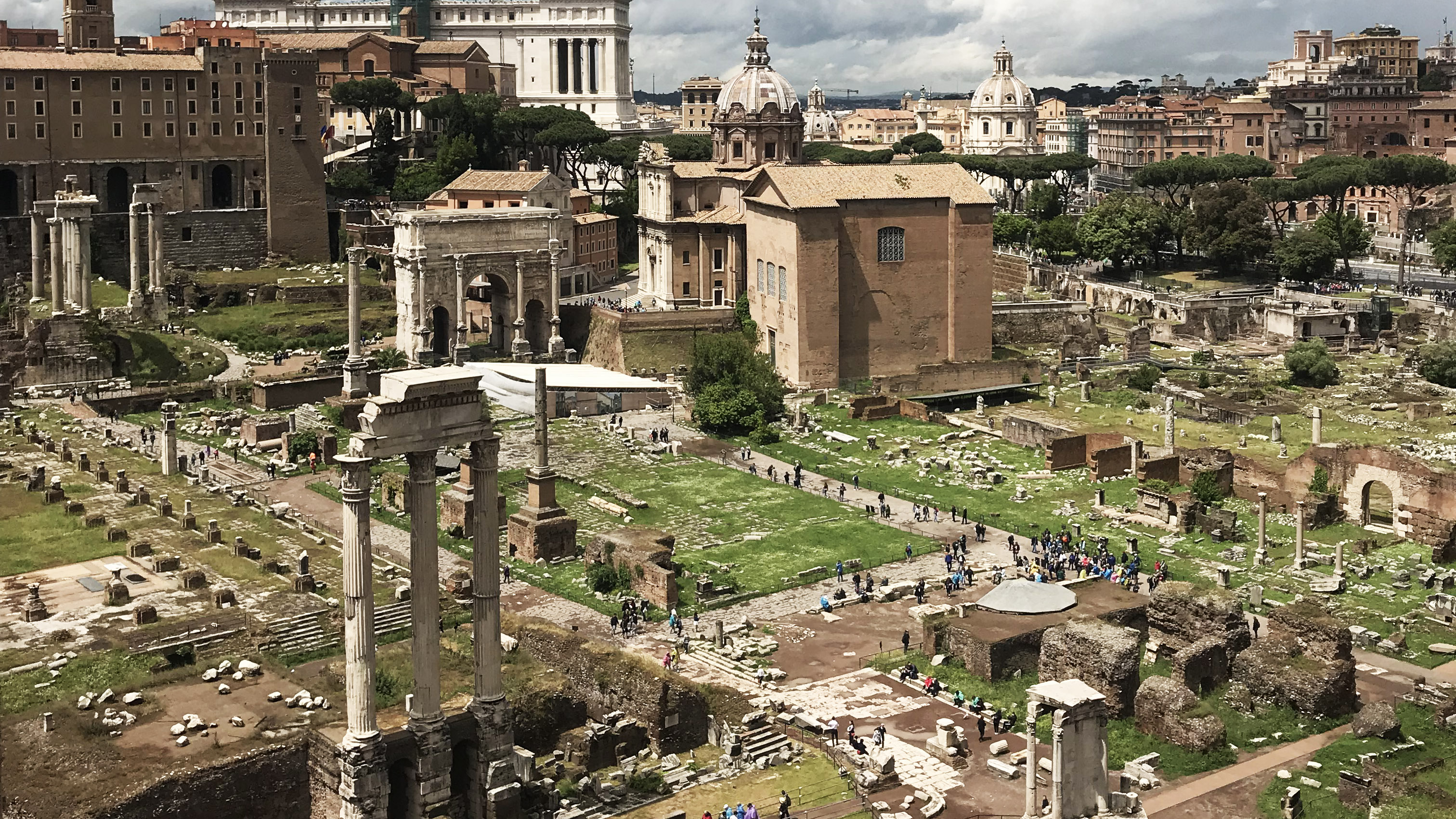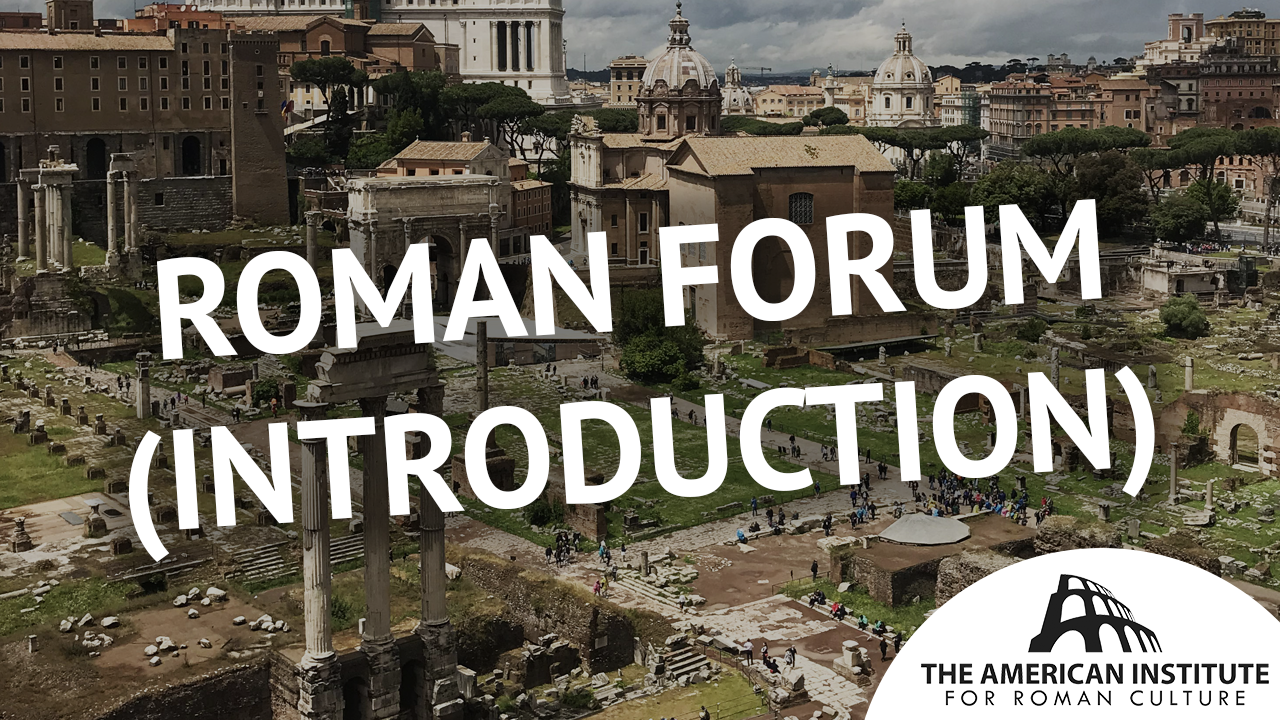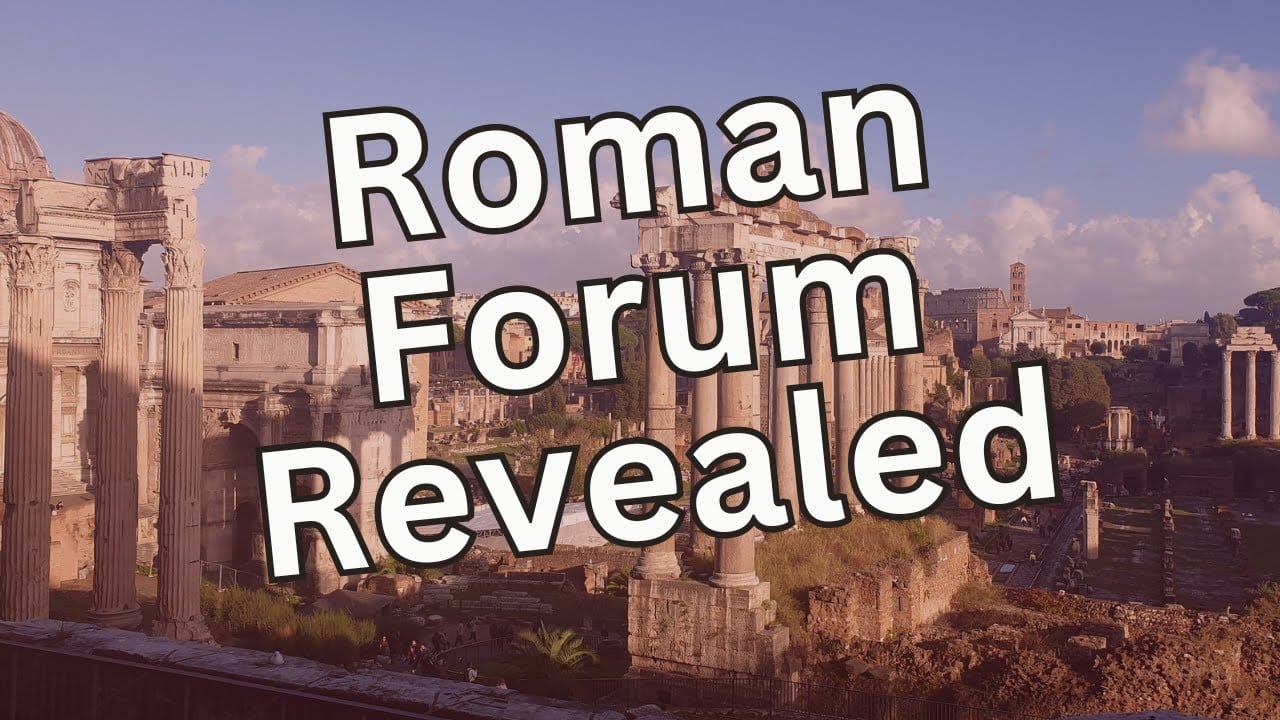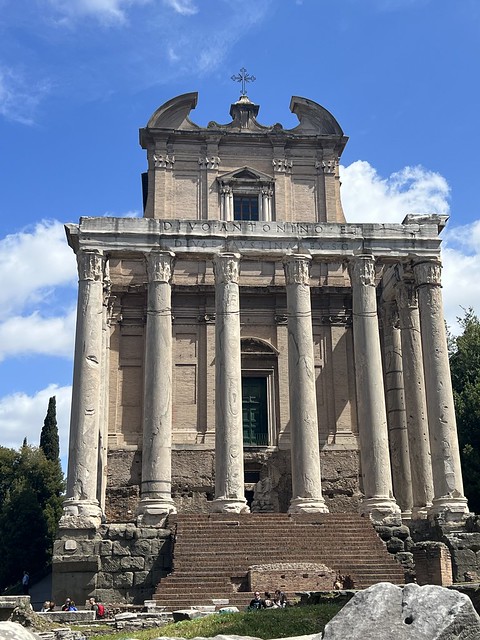There is no place more historic than the Roman Forum. Originally a swampy lowland characterized by many springs between the Capitoline and Palatine hills, the forum developed into the epicenter of Rome as a flat, open space for commerce and trade, judging and voting, and decision-making from the Comitium and Curia, essentially the heart of the ancient city. Initially, activities focused on the two natural shelves, at the base of the Capitoline and along the lower slopes of the Palatine, but soon enough the area was drained out (eventually made underground by the end of the Republic). Republican Rome included early temples (e.g., Vesta, Saturn, and Castors), with covered halls, known as basilicas, created by the second century BC. Julius Caesar saw to major revisions on the basilicas and Curia with a stand-alone Rostra, culminating under Augustus’ projects, with a victory arch and the Temple of Divus Iulius. Second century AD additions included the Temple of Vespasian and Temple of Faustina and Antoninus Pius. A late addition was the Arch of Septimius Severus. The fire of Carinus in 283 led to the rebuilding of the Basilica Iulia and Curia. Honorary columns were added by Diocletian or Constantine, who also added a second rostra and equestrian statue in the central piazza. Alaric the Goth’s sack of Rome in 410 was devastating, destroying the Basilica Aemilia, but the entire forum area was artificially raised a whole meter only by as late as 1000. The piazza remained more or less visible for a few more hundred more years, with access always to into the Curia, which had become a church. By the Renaissance, the forum was largely a cow pasture and occasionally pilfered for building materials. Full-scale excavations took place under Giacomo Boni after the unification of Italy in 1870. He unearthed the piazza and liberated the structures built into and around the principal columns and monuments still visible and standing. He rediscovered the Lacus Iuturnae and Santa Maria Antiqua by the destruction of S. Maria Liberatrice.
FORUM (ROMANUM S. MAGNUM), * at first the market-place, and later the civic centre of ancient Rome. The adjunct Romanum is not common (Verg. Aen. viii. 361; Plin NH. xix. 23; Tac. Ann. xii. 24; Suet. Aug. 72: so ἡ ἀγορὰ ἡ τῶν ῾Ρωμαίων Dionys. i. 87 (here only); Cass. Dio lix. 28: η9 ἀγορὰ ἡ ῾Ρωμαῖα; epit. lxiv. 6: ἡ ῾Ρωμαίωνἀγορά); while magnum is not classical, though Cass. Dio xliii. 22, who here too 1 calls it ‘῾Ρωμαῖα, says that it was called μεγάλη after the construction of the forum Iulium. Strabo v. 3. 8. 236 calls it ; ἡ ἀρχαῖα ἀγορά. Cf. Jord. i. 2. 410.
Read more:
In Not. Regio VIII it is called Forum Romanum vel (et) magnum. The etymology is uncertain; the derivation from ferre is generally discarded, but nothing has been found to take its place.
The valley of the forum, and its continuation, the Velabrum, was at first a marshy valley, traversed by a stream, which served as one of the defences of the Palatine city and separated it from the Capitol and Quirinal; and the first extension of the original settlement towards the east and south, by which the ‘Septimontium ‘ city was formed, still left it out. Outside the boundaries of this city, and on the edge of the valley there lay a burial ground, the so-called SEPULCRETUM (q.v.), the earliest tombs of which are variously dated, though the latest must go down to the end of the seventh or the middle of the sixth century B.C.
Roman tradition long preserved the memory of the original state of the forum (cf. Ov. Fasti vi. 401 : hic ubi nunc fora sunt, udae tenuere paludes; omneredundatis fossa madebat aquis. Curtius ille lacus, siccas qui sustinat aras, nunc solida est tellus; sed lacus ante fuit).
The testimony of geology also shows that the centre of the valley was originally a swamp. Traces of man’s presence were still found at 3.60 metres above sea-level (the lowest point reached in the excavations) near the foundations of the equestrian statue of Domitian, in the shape of fragments of carbonised wood; while, at between 6 and 7 metres above sea-level, the skeletons of three individuals (if not more) were brought to light. No proper report is as yet available, but Mosso studied the skull of a female, which he found to be very small and dolichocephalic. The height was only 1.22 metre; and near her was found the skeleton of a newly born infant. All three individuals were unburied; while a child found close by had been placed on a hollowed piece of wood, with a small vase near it (NS 1906, 46-50). The archaic vases found in a travertine block enclosed in the concrete base of the EQUUS DOMITIANI (q.v.) belonged no doubt to a tomb, being exactly similar to those of the sepulcretum.
Hulsen indeed rightly claims that from the point of view of early Roman history, the confirmation of the traditional ascription of the cloaca Maxima to the Tarquins, who ruled over Rome in the sixth century B.C. (at the time, that is, when the necropolis ceased to be used) is one of the most important results of the recent excavations (HC 4).
The forum thus became a market-place-quo conferrent suas controversias, etquae vendere vellent quo ferrent, forum appellarunt (Varro, LL v. 145). On each side there was a row of tabernae-the older, the veteres, on the south side, facing away from the sun; while another row, the novae, was later on placed on the opposite side. Games were also held here on the occasion of festivals or funerals, from the earliest times; justice was administered here, and it naturally became a place of public resort, first for business, then for politics and popular assembles, and later on for idleness or amusement. In this it was not dissimilar to the fora of other Roman cities in Italy and elsewhere. Fest. 84 says that there are six senses of the word: primo negotiationis locus … alio, in quo iudicia fieri, cum populo agi, contiones haberi solent (the rest does not concern us); but the COMITIUM (q.v.) was peculiar to Rome, and was the stronghold of aristocratic government and tradition. This was a slightly higher area in front of the curia, which adjoined the forum on the north-east, being separated from it by the ROSTRA VETERA (q.v.) with the SEPULCRUM ROMULI (q.v.), while the VOLCANAL (q.v.) higher still, rose on the north-west, on the slopes of the Capitol.
The open area of the forum was traversed by triumphal processions on their way up to the clivus Capitolinus; but it is probable that the Sacra via, which entered at the south-east end, near the Regia, did not at first have a regularly marked-off course under ordinary circumstances. Other streets which radiated from this centre were the ARGILETUM (q.v.), and another street on the further side of the Tabernae Novae,2 which led to the Subura and the vicus Longus; the VICUS IUGARIUS and VICUS TUSCUS (q.v.), which led on each side of the Tabernae Veteres through the Velabrum to the forum Boarium, and so towards the river; the steps near the temple of Vesta, leading up to the Nova via and on to the clivus Victoriae; and the street between the curia and the temple of Concord, which led past the LAUTUMIAE (q.v.) (from which at first it took its name, being called clivus Argentarius under the late empire), which gave access to the campus Martius and to the roads to the north.
Conflicting influences are visible in the orientation of the buildings of the forum. The religious orientation of the earliest period, which followed the points of the compass, was always maintained in the shrine of Iuturna, the regia and the temple of Vesta, in the comitium and rostra until the time of Julius Caesar, and in the atrium Vestae (which, strictly speaking, lies, like the temple, outside the forum) until that of Nero. On the other hand, the line of direction of the temples of Saturn and of Castor (the lacus Iuturnae, at first orientated with the precinct of Vesta, was afterwards made to conform with this temple), which date from the beginning of the fifth century B.C., already began at that period to exert an influence the other way, which finally triumphed in the main. The Tabernae Veteres, and the various basilicas which succeeded them, doubtless conformed to it; and so did the Tabernae Novae, and consequently the basilica Aemilia. Julius Caesar’s transference of the rostra and reconstruction of the curia dealt (with the exceptions noted above) the final blow to the old orientation (Mem. L. 5. xvii. 506, 511).
The first indubitable signs of the existence of an open area with well- defined limits and at a fixed level appear at IO.60-10.90 metres above sea, and are to be recognised in the following remains of cappellaccio pavements: (a) in front of the basilica Aemilia (CR 1901, 138) ; (b) in front of the temple of Julius Caesar; (c) under the fountain of Iuturna (but this may have been the floor of a basin; cf. NS 1901, 112-113; CR 19o, 141) ; (d) behind the republican Atrium Vestae.
To the next period (circa 174 B.C.) we must assign a level some half metre higher, which can be traced in the comitium, though in the forum proper there is nothing corresponding to it, except perhaps the remains of the pavement of the clivus Capitolinus of that date on the north-west side of the temple of Saturn, at 13.97 metres above sea-level. This is the period of the erection of permanent structures, called BASILICAE (see B. AEMILIA, PORCIA, SEMPRONIA) behind the two rows of tabernae- large covered halls which provided shelter from sun and rain, in which courts of law sat, and business was transacted. For the aspect of the forum at this time, see HC 12. fig. 4, and cf. Plaut. Curc. iv. I. 15. Another epoch in its history came, when, in 145 B.C., the Comitia Tributa were transferred to the forum by the tribune C. Licinius Crassus, who, for the first time, addressed the people in the forum from the rostra, and turned his back on the comitium. In 121 B.C. the restorer of the temple of Concord, Opimius, built a basilica close to it (see BASILICA OPIMIA).
The next level, which is in general 11.80 to 11.90 metres above sea, has been recently assigned to Sulla3 by Dr. Van Deman (JRS 1922, 1-31), who enumerates (p. 10) a number of pavements which belong to it: (I) those of Monte Verde tufa, near the shrine of Venus Cloacina and at the lacus Curtius, and the remains of a similar pavement near the concrete base in front of the temple of Julius Caesar. There are pieces of similar pavement outside the area of the forum proper, near the arch of Augustus and the temple of Vesta (p. 20); (2) those of brick tesserae under the vicus Tuscus (CR 1899, 466; BC 1899, 253) and under the arches at the west end of the forum (called by Boni ‘rostra Vetera ‘) ; and (3) the selce pavement of the street under the east front of the arch of Augustus (which was also found among the foundations of the temple of Julius Caesar), which is commonly called the vicus Vestae. A row of pozzi 4 parallel to it has been traced on the side towards the forum. (There are also indications of a corresponding level in the comitium.) To this level conform the earlier basilica Aemilia, the shrine of Venus Cloacina, the lacus Curtius, and the fountain of Iuturna.
The central area of the Sullan forum was enclosed on three sides by streets paved with polygonal blocks of selce, which took the place of the early cappellaccio slabs; and some remains of the pavement of the clivus Capitolinus above that of 174 B.C., at 14.50 metres above sea-level, belong to this period also. So also does the viaduct (which Boni calls the rostra Vetera, but cf. ROSTRA, p. 451, and CLIVUS CAPITOLINUS), the top of which is at the same level (p. 16). Of buildings assignable to the period of Sulla we know of little except the curia and the rostra, both of which were restored by him; while the temple of Jupiter Capitolinus and the Tabularium were finished by Catulus.
The next level is 12.60 metres above sea-level. To this belong the travertine curbs of the shafts leading down to the remarkable series of cuniculi, as they are generally called 5-underground passages the main line of which runs from the south-east end of the forum to the rostra of Augustus, with branches diverging at right angles (for plan see HC 139, fig. 69). A few pieces of white marble pavement at this level have been brought to light ; and to it, too, belongs the restoration of the pavement of the lacus Curtius in slabs of travertine. This level is undoubtedly to be assigned to Julius Caesar’s remodelling of the forum: Pliny tells us that when he gave a gladiatorial show, he covered the whole forum with awnings, as well as the Sacra via from his own house downwards and the whole of the clivus Capitolinus (NH xix. 23).
The travertine pavement of the forum of the Augustan period which is dated to that period by the inscription of L. Naevius Surdinus 6 (see TRIBUNAL PRAETORIUM) rises from 12.60 metres above sea-level in front of the temple of Julius Caesar to 14 metres above sea-level in front of the rostra of Augustus along the line of the main axis of the central area (JRS 1922, 1-2). The discovery of this inscription proved conclusively that this pavement continued to be in use until the end of the classical period, and that it was not, as had previously been believed, the work of a later date. The comitium had, largely owing to the erection of the rostra of Caesar and of the SAEPTA (q.v.), lost most of its political importance; and the forum, transformed by Augustus, who continued and carried out the designs of Julius Caesar, has come down to us much as he left it. The majority of the buildings by which it is surrounded belong to his time-the temples of Saturn, Concord, Castor and Julius Caesar, and the rostra, the two basilicas, the regia and the milliarium aureum. The curia, though reconstructed by Diocletian, occupies the site of the curia Iulia; and the only other monuments we have to add are the temples of Vespasian and of Antoninus and Faustina (the latter really lies outside the limits of the forum proper), the arch of Septimius Severus, the portico of the Dii Consentes, and the umbilicus.
The famous reliefs which are believed to have stood on the ROSTRA of Augustus (q.v.), whether they belong to the period of Domitian or of Trajan, represent in all its essentials the forum as it was recreated by Augustus. (See also Ills. 27, 28.) The equestrian statue of Domitian (EQUUS DOMITIANI, q.v.) made only an ephemeral appearance in the central area of the forum; the tribunal of Trajan never existed; and this area must have long remained clear of monuments of any sort.
In 283, under Carinus, a great fire raged in the forum, which gave an opportunity for extensive building operations by Diocletian and his successors.
The seven bases which flank the Sacra via, opposite the basilica Iulia, are attributed to the period of Diocletian owing to the existence in them of brick-stamps of Constantine (CIL xv. 1569, a, 3, 4; 1643, b, 4). But inasmuch as the brickfaced concrete of some of them shows clear traces of having been built round a core of opus quadratum, we must suppose either that the nucleus was formed of this material, or that this belongs to similar bases for statues of an earlier period (Jord. i. 2. 179-184; ZA 85). The columns along the Sacra via are represented in the relief referred to on p. 452. Though the brickwork of the base of the column of Phocas is similar to that of the other bases, it is perhaps unlikely that it was erected as early as the time of Diocletian (though certainly long before 608 A.D.), as it would have obstructed the front of the rostra (Mitt. 1902, 59-60; 1905, 68). On the other hand, an equestrian statue of Constantine (EQUUS CONSTANTINI) was erected in the centre of the area, just to the south-east of the spot where that of Domitian had stood.
But the transfer of the imperial residence to Byzantium led to an inevitable decline ; and the forum became the scene of struggles between Paganism and Christianity. Monuments of the beginning of the fifth century may be found there (see ROSTRA AUGUSTI), but in 410 the fires which accompanied the plundering of Rome by Alaric destroyed many of the buildings of the forum, and notably the basilica Aemilia, which was never rebuilt. A terrible earthquake is recorded in 442 (Paul. Diac. Hist. Lang. xiii. 16); while in 455 the Vandals under Gaiseric pillaged Rome; and the inscription placed on the rostra in commemora- tion of the naval victory of 470 is the last monument of the western empire in the forum. Theodoric (483-526), on the other hand, must have repaired many of the buildings of the forum, where a considerable number of bricks bearing his name have been found (HC 26; all that are actually published are CIL xv. 1665a low down in the favissa of the temple of Vesta, and the same stamp and ib. 1669 in the roof of the old church of S. Martina) ; and Theodohad’s care for certain bronze statues of elephants (probably from an arch of triumph) in 535-6 is testified to by Cassiodorus (Var. x. 30). The first church in the forum was SS. Cosmas and Damianus (526-530), while the origin of S. Maria Antiqua is probably even earlier; S. Hadrianus and S. Martina occupied the curia and the secretarium about 20 years after the dedication of the column of Phocas (608 A.D.); while the basilica Aemilia and the atrium Vestae became the dwellings of Byzantine or papal officials.
It was the earthquake in the time of Pope Leo IV in 847 (LPD ii. 108:huius beatitempore praesulis terre motus in urbe Roma per indictionem factus est x,7 itaut omnia elementa concussa viderentur ab omnibus) which led to the destruction not only of S. Maria Antiqua, but of the majority of the monuments of the forum; and probably the fire of Robert Guiscard in 1084 caused great damage also. Certainly about 1130 the centre of the forum was entirely impassable (cf. Liber Politicus Benedicti ap. Fabre, Liber Censuum, ii. 158); and the description given in the Mirabilia, the genesis of which dates from this period, shows a curious mixture of real knowledge, false conjecture and pure imagina- tion. The level of the forum rose gradually (cf. CURIA IULIA; HC fig. 53), and desolation increased. The return of Pope Urban V from Avignon (1367) led to an increased interest in ancient monuments, though they were often sacrificed as building material; and during the Renaissance this latter tendency became much stronger, despite the general spread of classical culture. In fact, the very architects who measured and drew the remains of antiquity were most active in using them as quarries for their own build- ings. But we also have numerous sketches by artists, which cannot be enumerated here, but are of the highest value for our knowledge. A few notable finds of inscriptions and fragments of architecture were made; but nothing was attempted in the way of scientific excavation until the end of the eighteenth century, when a part of the basilica Iulia was laid bare, but incorrectly identified.
In 1803 Fea began by clearing the arch of Severus, and the work was continued by the French, the temples of Saturn and Vespasian being isolated, and the column of Phocas cleared; the temples of Castor and Concord followed. The work was continued in 1827-36, and the isolated excavations connected; but very little more was done until after 1870, when the work was taken in hand seriously (though at first with too little regard to the late classical period, see LR 244-245), and the forum and Sacra via cleared from the Tabularium to the arch of Titus. Work stopped again in 1885, and was not resumed again until 1898, when extensive excavations were begun by Boni and carried to the lowest strata at many points over the whole area. In this connection a passage in LR 240, written in 1897, just before Boni’s excavations began, should be quoted. ‘ It is necessary to remind the reader that the excavations of the Forum and of the Palatine have nowhere been carried to the proper depth. We have satisfied ourselves with laying bare the remains of the late empire, without taking care to explore the earlier and deeper strata.’ At the same time came the addition of the site of the basilica Aemilia and of the comitium; and the demolition of the church of S. Maria Liberatrice rendered it possible to connect up the forum with the Palatine, and to lay bare the lacus Iuturnae, the whole group of S. Maria Antiqua, the horrea Agrippiana, etc.
The best guides to the voluminous literature of the forum, and to its history through the ages are: Jord. i. 2. 155-429; cf. EE iii. 238– 248; LR 221-294; LS passim.
For the recent excavations, see Vaglieri in BC 1903, 3-239; Boni in Atti 493-584-his reports in NS only deal with the temple of VESTA, the LACUS IUTURNAE, the COMITIUM, and the SEPULCRETUM (qq. v.); cf. also CR 1899-1906 passim-CQ 1908, 142-150; Thedenat, Forum Romanum (ed. 4, 1908); Hulsen, Forum Romanum, tr. Carter (ed. 2, 1909), and Nachtrag, Rome, 1910; Forum und Palatin, Berlin, 1926 (English edition, New York, 1928); and inMitt. 1902, 1-97; 1905, 1-119; De Ruggiero, Foro Romano, Rome, 1913; RE Suppl. iv. 461-511. For the forum in Christian times see Leclercq in Cabrol, Dict. v. 1997– 2065. For a restoration, see D’Esp. Mon. ii. 84-86.
This content is brought to you by The American Institute for Roman Culture, a 501(C)3 US Non-Profit Organization.
Please support our mission to aid learning and understanding of ancient Rome through free-to-access content by donating today.
Cite This Page
Cite this page as: Darius Arya, The American Institute for Roman Culture, “Forum Romanum (Roman Forum) – Introduction” Ancient Rome Live. Last modified 09/15/2020. https://ancientromelive.org/forum-romanum-roman-forum/
License
Created by The American Institute of Roman Culture, published on 10/24/2019 under the following license: Creative Commons: Attribution-NonCommercial-ShareAlike. This license lets others remix, tweak, and build upon this content non-commercially, as long as they credit the author and license their new creations under the identical terms. Please note that content linked from this page may have different licensing terms.





